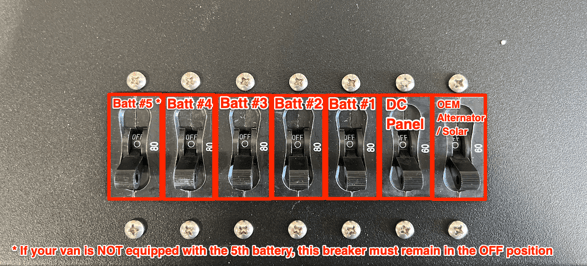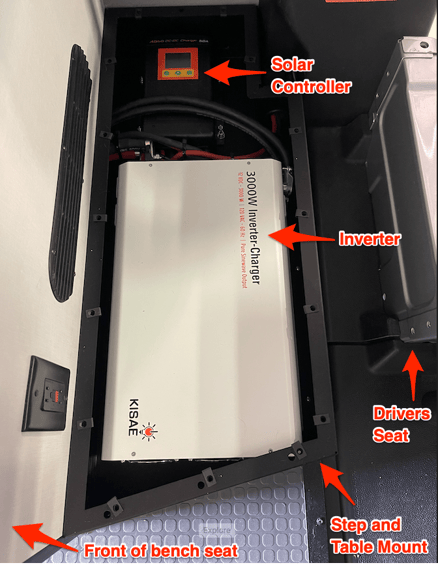Upgraded Components (2nd & 3rd Gen Revels)
Learn about the components that we upgrade and add with every RoamRig 2nd & 3rd Generation power installation and where to find them in your van.
Parts included (where are components located?)
- Kisae BIC1230100 pure sine wave inverter/charger
- Kisae DMT1250 DC-DC converter w/ MPPT solar controller. 750w maximum solar input at 50 VOC max.
- Victron BMV712 bluetooth battery monitor
- Balmar 250A alternator with MC-618 regulator and associated mounting hardware
- 2021-2022 Revels: 2 or 3 additional Lithionics 12V130A-G31-LRBM8 batteries (the same as the stock Xantrex batteries which are made by Lithionics and branded as Xantrex)
- 2023 Revels: 2 or 3 additional 320ah Lithionics batteries mounted in the current battery location
Why did you change the inverter?
The chosen 3000w inverter is able to run the air conditioning with no soft start. Additionally, it can run the air conditioning while you use other high power appliances like the inductive cooktop. Finally, it has a built-in 100 amp DC battery charger for quickly charging your house battery bank when you are plugged into shore power.
Why did you move the inverter?
The inverter is moved to a new steel step in front of the bench seat for a variety of reasons. First, it creates room in the back for the new batteries. Second, it moves the inverter to a space that is not heated by sun shining on the driver's side of the van. We found that in hot weather with the stock inverter in the back of the van, the inverter was prone to overheating if there was sun on the driver's side of the van where the inverter was mounted.
Why do you not install heaters on the batteries?
The Winnebago installed heaters are a bit of a paradox. They presume that the batteries are warm enough to be used in order to operate them. If the batteries are warm enough to be used, you can run the coach heat and the mere action of discharging power from the heaters will keep the batteries warm enough to be used/charged. If the batteries are too cold to be used, the heaters are of no use in "waking" the batteries up as the heaters can only be powered via the batteries themselves and not via external sources. Battery heaters do make sense for certain applications which is primarily when the batteries are mounted in a non-heated exterior location.
What is the warranty?
Each component of the RoamRig system has a manufacturer warranty. The batteries have a lifetime warranty! The interconnecting components and installation will be warrantied by RoamRig (not the installation partner) for 1 year from the completion of the installation. For simple repairs or issues, RoamRig will provide direction for you so that you can quickly get back on the road, exploring the world!
Component Locations
In addition to the switch panel, familiarize yourself with the location of components related to your RoamRig power system:
- Batteries: In 2nd Generation and later systems, your house batteries are in a compartment in back. For 3rd Generation systems with 3 batteries, your batteries are also in the back compartment with the optional fourth battery in the GLSS.
- DC Breaker Panel: The DC breaker panel is located above the batteries.


- Inverter and Charge Controller: The inverter (including the GFCI outlet) and the charger controller for DC to DC and solar charging are both located under the bench seat.

